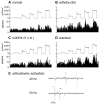Spinal CGRP1 receptors contribute to supraspinally organized pain behavior and pain-related sensitization of amygdala neurons
- PMID: 17335972
- PMCID: PMC2066202
- DOI: 10.1016/j.pain.2007.01.024
Spinal CGRP1 receptors contribute to supraspinally organized pain behavior and pain-related sensitization of amygdala neurons
Abstract
CGRP receptor activation has been implicated in peripheral and central sensitization. The role of spinal CGRP receptors in supraspinal pain processing and higher integrated pain behavior is not known. Here we studied the effect of spinal inhibition of CGRP1 receptors on supraspinally organized vocalizations and activity of amygdala neurons. Our previous studies showed that pain-related audible and ultrasonic vocalizations are modulated by the central nucleus of the amygdala (CeA). Vocalizations in the audible and ultrasonic range and hindlimb withdrawal thresholds were measured in awake adult rats before and 5-6h after induction of arthritis by intra-articular injections of kaolin and carrageenan into one knee. Extracellular single-unit recordings were made from neurons in the latero-capsular division of the CeA (CeLC) in anesthetized rats before and after arthritis induction. CGRP1 receptor antagonists were applied to the lumbar spinal cord intrathecally (5 microl/min) 6h postinduction of arthritis. Spinal administration of peptide (CGRP8-37, 1 microM) and non-peptide (BIBN4096BS, 1 microM) CGRP1 receptor antagonists significantly inhibited the increased responses of CeLC neurons to mechanical stimulation of the arthritic knee but had no effect under normal conditions. In arthritic rats, the antagonists also inhibited the audible and ultrasonic components of vocalizations evoked by noxious stimuli and increased the threshold of hindlimb withdrawal reflexes. The antagonists had no effect on vocalizations and spinal reflexes in normal rats. These data suggest that spinal CGRP1 receptors are not only important for spinal pain mechanisms but also contribute significantly to the transmission of nociceptive information to the amygdala and to higher integrated behavior.
Figures









Similar articles
-
Critical role of calcitonin gene-related peptide 1 receptors in the amygdala in synaptic plasticity and pain behavior.J Neurosci. 2005 Nov 16;25(46):10717-28. doi: 10.1523/JNEUROSCI.4112-05.2005. J Neurosci. 2005. PMID: 16291945 Free PMC article.
-
Amygdala group II mGluRs mediate the inhibitory effects of systemic group II mGluR activation on behavior and spinal neurons in a rat model of arthritis pain.Neuropharmacology. 2019 Nov 1;158:107706. doi: 10.1016/j.neuropharm.2019.107706. Epub 2019 Jul 12. Neuropharmacology. 2019. PMID: 31306647 Free PMC article.
-
mGluR1 and mGluR5 antagonists in the amygdala inhibit different components of audible and ultrasonic vocalizations in a model of arthritic pain.Pain. 2005 Jan;113(1-2):211-22. doi: 10.1016/j.pain.2004.10.022. Pain. 2005. PMID: 15621382
-
Mechanisms of pain in arthritis.Ann N Y Acad Sci. 2002 Jun;966:343-54. doi: 10.1111/j.1749-6632.2002.tb04234.x. Ann N Y Acad Sci. 2002. PMID: 12114291 Review.
-
Spinal pain processing in arthritis: Neuron and glia (inter)actions.J Neurochem. 2024 Nov;168(11):3644-3662. doi: 10.1111/jnc.15742. Epub 2023 Jan 5. J Neurochem. 2024. PMID: 36520021 Review.
Cited by
-
Fear Extinction-Based Inter-Individual and Sex Differences in Pain-Related Vocalizations and Anxiety-like Behaviors but Not Nocifensive Reflexes.Brain Sci. 2021 Oct 11;11(10):1339. doi: 10.3390/brainsci11101339. Brain Sci. 2021. PMID: 34679403 Free PMC article.
-
Elevated levels of calcitonin gene-related peptide in upper spinal cord promotes sensitization of primary trigeminal nociceptive neurons.Neuroscience. 2016 Dec 17;339:491-501. doi: 10.1016/j.neuroscience.2016.10.013. Epub 2016 Oct 13. Neuroscience. 2016. PMID: 27746346 Free PMC article.
-
Description of Novel Molecular Factors in Lumbar DRGs and Spinal Cord Factors Underlying Development of Neuropathic Pain Component in the Animal Model of Osteoarthritis.Mol Neurobiol. 2024 Mar;61(3):1580-1592. doi: 10.1007/s12035-023-03619-x. Epub 2023 Sep 21. Mol Neurobiol. 2024. PMID: 37731080 Free PMC article.
-
Calcitonin gene-related peptide (CGRP) receptor antagonists in the treatment of migraine.CNS Drugs. 2010 Jul;24(7):539-48. doi: 10.2165/11534920-000000000-00000. CNS Drugs. 2010. PMID: 20433208 Free PMC article.
-
Facilitation of synaptic transmission and pain responses by CGRP in the amygdala of normal rats.Mol Pain. 2010 Feb 8;6:10. doi: 10.1186/1744-8069-6-10. Mol Pain. 2010. PMID: 20144185 Free PMC article.
References
-
- Bernard J-F, Bester H, Besson JM. Involvement of the spino-parabrachio -amygdaloid and -hypothalamic pathways in the autonomic and affective emotional aspects of pain. Prog Brain Res. 1996;107:243–255. - PubMed
-
- Borszcz GS. Increases in vocalization and motor reflex thresholds are influenced by the site of morphine microinjection: comparisons following administration into the periaqueductal gray, ventral medulla, and spinal subarachnoid space. Behav Neurosci. 1995;109:502–522. - PubMed
-
- Borszcz GS, Johnson CP, Williams DH. Increases in vocalization and motor reflex thresholds generated by the intrathecal administration of serotonin or norepinephrine. Behav Neurosci. 1996;110:809–822. - PubMed
-
- Borszcz GS, Leaton RN. The effect of amygdala lesions on conditional and unconditional vocalizations in rats. Neurobiol Learn and Mem. 2003;79:212–225. - PubMed
-
- Borta A, Wohr M, Schwarting RKW. Rat ultrasonic vocalization in aversively motivated situations and the role of individual differences in anxiety-related behavior. Behavioural Brain Research. 2006;166:271–280. - PubMed
Publication types
MeSH terms
Substances
Grants and funding
LinkOut - more resources
Full Text Sources
Other Literature Sources
Medical
Research Materials

